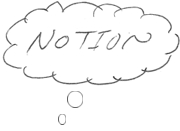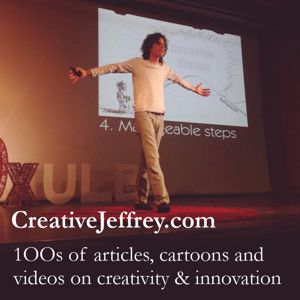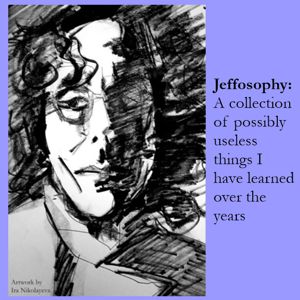Report 103
Your newsletter on applied creativity, imagination, ideas and innovation in business.
Wednesday 30 January 2013
Issue 221
Hello and welcome to another issue of Report 103, your twice-monthly (or thereabouts) newsletter on creativity, imagination, ideas and innovation in business.
As always, if you have news about creativity, imagination, ideas, or innovation please feel free to forward it to me for potential inclusion in Report103. Your comments and feedback are also always welcome.
Information on unsubscribing, archives, reprinting articles, etc can be found at the end of this newsletter.
Note
Most articles in this issue of Report 103 can also be found in the archives together with dozens more articles, papers and thoughts.
In this issue of Report 103
- The Creative Idea
- Anticonventional Thinking (adv)
- States of Ideas
Also some self promotional stuff about anticonventional thinking....
The Creative Idea
Jeffrey Baumgartner
What is a creative idea? A mystical gift from your God? The discovery of something new? A profound insight of almost spiritual proportions? An irritant to rational thinking? A creative idea can be any of these things. But to understand creativity and how you have ideas, it helps to take a somewhat more clinical perspective. In terms of your brain, memories and creativity, let's look at what exactly happens when you have a creative idea.
But first, we need to talk about notions

Note: if you cannot see the images in your email, you can also read
this article on line here
A notion is a piece of information stored away in your brain's memory. It could be a bit of information you learned at school, it could be something you read in a book, it could be your reaction to something you have seen, smelled or tasted. Notions do not need to be factual or even true. If you believe in Santa Claus, then this is a valid notion as far as you are concerned. If you believe that Picasso was a better artist than Dali, this is also a valid notion as far as you are concerned.

Whenever two or more notions come together to create a unique, all new notion in your mind, a creative idea is born. The notion of small sheets of note paper combined with the notion of slightly sticky glue became the creative idea of Post-It notes. The notion of nitrous oxide (also known as laughing gas) and the notion of reducing pain during surgery became the creative idea of anaesthesia. Interestingly, although the effects of nitrous oxide were discovered by Sir Humphry Davy in a series of experiments in 1799 – it took another 40 years before someone combined this notion with the notion of dealing with pain. Nevertheless, once the discovery was made, you can assume a lot of people were slapping their foreheads and exclaiming, “why didn’t I think of that?”
Indeed, think about any creative idea or invention (which inevitable has been inspired by creative ideas) and you can deconstruct it into notions that were established at the time the idea or invention was born.

Once two or more notions have created an all new notion, or creative idea, that new notion becomes a part of your repository of notions that can be constructed into more creative ideas. For instance, once the idea of the Post-It had been realised, people quickly up with new ideas for using the notes: marking pages in a book, annotating documents without marring them and brainstorming to name but a few. Each of these new uses of Post-It notes were the result of a creative idea which was the result of the notion of a Post-It note being combined with other notions.
When you think about it, this is the amazing power of the creative idea. Not only does it give us something new and exciting, but it provides a new building block for creative ideas. Indeed, every invention, every innovation, every creative ideas we humans have ever had have been built upon the building blocks of previous ideas. And those goes all the way back to the cavemen and women combining such basic notions as banging rocks together to make a sharp stone and the notion of the potential usefulness of that sharp stone as a tool.
It’s very simple then. A creative idea is simply the result of two or
more notions coming together in the mind in order to create an all new notion;
a creative idea, which in turn becomes a useful notion for future creative ideas.
How Do People Have Creative Ideas?
Notions are stored in the average brain as memory and different kinds of memories
are stored in different parts of the brain. Moreover, it seems that similar
memories are stored in proximity to each other. Certainly, magnetic resonance
imaging (MRI) scans of people thinking seems to bear this out. That said, science
is only just beginning to understand how the brain forms, stores and accesses
memories.
As noted, we devise creative ideas as a means of finding a path to achieving
a particular goal. A composer wishes to express thoughts in a song, a scientist
seeks to explain a natural phenomenon, a designer seeks ways to improve a particular
kind of product. Incidentally, you can also consider creativity as a means of
solving problems, but I prefer to work with goals. Anyway, the need to solve
a problem is also a goal – so it's really the same thing.
Even when a creative idea seems to come to you out of the blue, it is almost
inevitably because it helps you achieve a goal. You may not be consciously thinking
about the goal, you may not even be terribly interested in achieving the relevant
goal, but you need to be aware of the goal in order to recognise the creative
idea. For instance, if you are relaxing in the bath and suddenly have a brilliant
and creative idea for a new curry to cook for dinner one day, that idea enables
you to achieve a goal: cook an interesting new meal for dinner. You may not
have been thinking of that goal. If you had no interest in food and only ever
ate peanut butter and jam sandwiches prepared by your mother, the notions of
combining various kinds of food in novel ways would not have happened in your
brain.
What Happens

If you take a person of average creativity and ask her to come up with ideas towards achieving a goal, she will probably focus her thinking on notions related to the nature of the goal. If, for instance, you have asked her to come up with creative ideas for using a shoebox, she will likely focus her thinking on boxes. This would probably inspire ideas about storing small things. She might remember that as a schoolgirl, she made dioramas in shoeboxes and suggest ideas about making dioramas and other decorative things. These ideas might inspire her to think further. But her ideas will still circle around her existing notions of small boxes and their uses.

If you could look insider her brain while this was happening – perhaps with a magnetic resonance imaging (MRI) scanner – you would probably see that a relatively small, focused area of her brain is active. This would be the area of her brain where she stores memories (ie. Notions) about small boxes.
At the same time that this is happening, a part of her brain known as the dorsolateral prefrontal cortex will inspect ideas before letting them develop. This is the bit of the brain is a sort of censorship filter that is responsible for regulation of thinking and action. It’s what prevents you from behaving in ways that would be inappropriate socially. It prevents you from saying stupid things that might cause your friends, colleagues and others to laugh at you or look down upon you. Basically, it keeps you out of trouble. And that’s a good thing.

Unfortunately, the censorship filter reviews ideas, when you are generating them, and stifles potentially stupid, crazy or embarrassing ideas. Unfortunately, those ideas are often also the most creative ideas. Indeed, most really great creative ideas initially sound stupid.

For example, imagine our averagely creative thinker is thinking about bras – perhaps she is planning to buy new ones at a sale later in the day – while generating ideas about boxes. As a result, she suddenly has a crazy idea to cut up the hypothetical shoe box and make it into a bra with cubical cups and give women more angular chests. Most likely, her censorship filter will immediately reject the idea as potentially embarrassing and stupid. So, before the idea has fully formed in her mind, it is rejected.
As a result, an averagely creative person can easily come up with moderately
creative ideas. But those ideas will centre around the nature of the goal. If
you demand that this person has lots of ideas (such as in a traditional brainstorm
or for a creativity exercise), she still will not veer far from the goal. She
cannot help it. It is the way her brain is wired.
People Who Are Exceptionally Creative Are Diffferent
People who are very creative, let’s call them “highly creative”, are different. Their brains seem to be wired differently in two significant ways. Firstly, when asked to find ideas to achieve a goal, they search around much more of their brains, looking for notions with which to build ideas. Clearly this is a powerful advantage in terms of creativity. If you can access a greater number of more diverse notions from which to create new notions, than can average people, it is simply easier to devise creative ideas; ideas that averagely creative people would never think about.
If we were to use our MRI scanner to look into the brain of a highly creative person trying to devise ways to achieve her goal, we would see much more of her brain is active as she searches many diverse memories for notions that she can combine to create ideas.

If our highly creative thinker is tasked with coming up with creative uses of a shoe box, she will – like the average person – think small boxes, storage and dioramas. But she will also think about many other seemingly unrelated things, such as shoes, clothing, toys, weapons, fuel for a fire and more. She will play with the box in her mind, take it different places. She will imagine what it is like inside the box. She will think about the box burning. She will cut up the box. She will throw it. As she is doing all of these things in her mind, various and seemingly unconnected notions come together to form ideas. Ordinary ideas and crazy ideas.
But that’s not all! The dorsolateral prefrontal cortex in the highly creative person becomes significantly less active than usual when she is developing ideas. In other words, she is far less likely to filter out ideas; she is far less likely to feel her ideas are inappropriate. As a result, her brain can play with and develop ideas that the averagely creative person's brain would reject in an instant. Moreover, she will not feel embarrassed about sharing her crazy ideas with others. She will not worry about people laughing at her or looking down upon her for having silly ideas.
This is what makes her highly creative: her brain. It's internal search engine
seeks far and wide for diverse notions to combine into ideas and its censorship
filter rejects few ideas, no matter how stupid they may seem to others. It is
also what makes her different to most people whose brains focus much more when
searching for notions and then reject far more notions as stupid or inappropriate.
In a nutshell, highly creative people's brains are wired differently than are
averagely creative people.
Getting More Creative
It seems that the way people think is largely hard-wired into their brains during childhood and cannot significantly be changed later in life. So, if you are not extremely creative, but wish to be, you cannot take medication, lessons or undergo brain surgery in order to make your brain think significantly more creatively than it does now.. And that is probably a good thing. Who and what you are is largely the result of the way you think. Radically changing how you think would radically change the kind of person you are, which could have unpleasant consequences. For instance, a successful accountant with an eye for detail and strong analytical skills might lose these precious skills if she could “rewire” her brain to be more creative!
Nevertheless, there things you can do to improve your ability to generate creative ideas. Understanding what creative ideas are, how we form them and how highly creative people differ from creative people enables us to judge what kind of tricks might actually help you be more creative and which are more likely to be wasting time. In some cases, research bears these judgements out.
The first thing to observe is that highly creative people generate ideas by exploring a diversity of notions in their minds and associating those notions with the creative goal. If she is looking for creative ideas incorporating a shoe box, she looks at the shoe box in many different ways and tries to associate it with a diversity of other notions.

In other words, her creativity comes not from the ideas or how many she generates, but from how she looks at the goal and associates it with other notions in her mind. This is why some of the classic creativity “tricks” work. For example, if you are stuck for ideas, a great trick is to open a dictionary (or any book) and randomly choose a word. Then try and find ideas that incorporate that word. This brings new notions to your goal (something highly creative people do naturally) and almost inevitably results in creative ideas. In fact, this simple trick is probably one of the best creative thinking tricks you can use!

Another trick is to let the goal sit in the back of your mind for a day or two. Go for a walk. Visit a museum. Read a book on an unrelated topic. As you do these things, think about your goal from time to time. If you are reading a novel, think about what kind of ideas the protagonist would devise in order to achieve a goal like yours. If you are visiting a museum, think about how you could associate exhibits with your goal.
Another, more recently discovered trick is to distance yourself from the goal. Imagine someone across the country or in another country has the same goal. What would you suggest to her? If you work in the London office of a multinational company, imagine the Mumbai office has a similar goal. What would you suggest they do? Distancing yourself from the goal gives you a new perspective on the goal and that brings new notions into your idea generation.
Another trick for generating creative ideas is to give your censorship filter different instructions. For instance, when generating ideas, consciously reject conventional ideas and seek unconventional ideas. If you are facilitating a brainstorm or other idea generation activity, make it clear that the most unique, craziest or most unusual ideas will be rewarded and selected. This tells participants to reject more conventional ideas. Better still, emphasise that boring, conventional ideas will be rejected.
Likewise, never, ever tell people in an ideation event that the “best ideas” will be rewarded and selected. “Best ideas” are, in most people's minds, tried and trusted ideas that have always worked in the past. Best ideas are conventional ideas. Indeed, as soon as you tell people the best ideas will win the brainstorm, their censorship filters will reject outlandish, unconventional ideas in favour of conventional ideas similar to those best ideas implemented in the past. As a result, you reduce the level of creativity you can expect in an ideation event!
Another useless creativity trick is to force yourself or a group to generate a lot ideas under the assumption that your brain will run out of conventional ideas and start thinking about unconventional ideas. Simply demanding your brain devises a lot of ideas does not help you bring more diverse notions together, nor does it instruct your censorship filter to reject conventional ideas in favour of unconventional ideas. However, if you combine a demand for as many ideas as possible with the tricks we've discussed above, then you can expect more creativity as well as more ideas.
To summarise, an individual's level of creativity is largely hard-wired into her brain and cannot be substantially changed. However, someone of average creativity can improve the creativity of her ideas by using tricks that enable her to associate her goals with notions unrelated to those goals and by consciously telling her mind to favour crazy, unusual ideas over conventional ideas.
Anticonventional Thinking (ACT)
Are you less than impressed with brainstorming? Do you believe there must be a more effective way to generate and implement creative ideas? There is: anticonventional thinking (ACT)!
ACT has been used by businesses and government bodies around the world to:
- Develop new product ideas.
- Generate ideas to revive existing products.
- Come up with innovative ways to improve existing products and outfox competitors.
- Model better processes.
- Devise development initiatives for economically troubled regions.
- Develop concepts to promote government initiatives.
- And much more
If you and your team had a powerful new way to generate and implement ideas,
what would you do? Let's
talk about how we can make it happen!
States of Ideas
By Alex Keenan
There is an underlying reason for any action within an organization. When one is trying to generate ideas there must be a need and/or opportunity that the ideas generates for it to have value to the organization. So clear understanding of the problem/opportunity is required for any type of meaningful evaluation of an idea. One must first start with a clear understanding of the problem and/or opportunity that one wishes to address. This implies that some current state is not the ideal or desired state. Ideas are nothing more than a means to achieve an alternate state. Many times there exists an idea state and several acceptable alternate states. By clearly defining the idea and acceptable alternate states one can determine if an idea can achieve a desired state. Defining also allows for providing a means to determine if a desired state has actually been achieved. For by clearly defining the state one is also defining constraints. The idea will have to fulfill these constraints in achieving the desired state. If the constraints are measurable then they can be monitored and controlled. For example I have a lemon cake recipe that produces a sour cake. My ideal state is a sweet cake but I can accept a semi-sweet cake. The cake must still be light, have a firm texture, have a mild crust, and still have a nice lemon flavor. So based on this I can have ideas that give me a sweet lemon cake and ideas that give me semi-sweet lemon cake. But for an idea to be accepted the cake still must be light, with a firm texture, have a mild crust, and still have a nice lemon flavor. Now I still need to define each of these traits in such a manner that allows me to verify if the trait was achieved or not achieved. But once this is done I now have an effective framework to evaluate ideas. I can determine success because I have clearly defined success.
To take this further requires an understanding of the environment an organization exists in. It also requires identifying constraints that exist related to the problem/opportunity. Constraints as in that which restricts, limits, or regulates the problem/opportunity in the environment that exists in which one will seek a solution. Identification of constraints is important because many times incremental improvements are developed working within constraints while disruptive innovation may require eliminating constraints. This means that the focus of ideas may have to change with each constraint or group of constraints. Each of these is a different state and may likely mean a different means to achieve the desired state or even a completely different state. Once this understanding is achieved then meaningful brainstorming can begin. There is now a solid framework to work within.
Now when brainstorming begins there can be several ideas for each state. For each idea there will be pros and cons. For each idea there will be time and resources required, etc. Many times there can be organizational cultural issues such as operational, financial, executive, engineer, etc. At an early stage, a framework can be created to get a very rough idea of these key items related to each idea. It also can help identify unknowns that would have to be known to properly evaluate a given idea. Capturing high level information for each idea instead of rejecting ideas can allow for understanding. It is not uncommon for an idea to have to mature or evolve. By killing an idea early this cannot happen. I have seen many ideas that were rejected because they were poorly understood. They were poorly understood because the person with the idea could not adequately verbalize the idea in a manner that others could mentally comprehend. This is especially true with disruptive innovation. Sometimes these ideas require a model, a proof of concept or similar in order to be appreciated. By having a group work on the pros and cons and main characteristics there is a greater likelihood of achieving an understanding of the basic concepts of the idea. This increases the likelihood that disruptive innovation ideas will not be rejected out of hand. Ideas that cannot be defined adequately can be marked for more development.
It is likely that brainstorming will develop more ideas than one has ability to truly analyses in depth. Defining the problem/opportunity helps keep the ideas focused. Having the idea traits helps provide means for triage of ideas. One can quickly determine the dead, living, and ones that need help. Culture plays an important role in accepting and rejecting ideas. Many times operational managers want from three to five safe solutions to a given problem. This seems to be very common in western culture. The key term here is safe as in perceived to be safe. For survival in operational management generally means taking the safe course of action. This is much the same as water seeking the path of least resistance.
You see corporate culture playing its role many times. For example, it is generally the engineering culture of technologists, within an organization, that is willing to assume risk to adopt new technologies. They are also more likely to adopt ideas that reduce head count in favor of automation. Where operational management are more likely to favor ideas that involve training and human solutions. At the same time it is not uncommon to see executive level management focusing on ROI or ideas offering financial benefits. This is because in any organization there is not a single culture but a stew of different cultures interacting with one another. Each culture will filter ideas through their cultural values. This can lead to conflict in selecting solutions. Ideas can be championed by different cultures within an organization. Each culture can be right from their point of view. Compromise may be required resulting in a workable but not perfect solution. So when evaluating ideas it may be desirable to have members of the different cultures or some form of cultural review.
Is the idea crazy or uncomfortable? Many things we take for granted today were considered crazy ideas by most people just a generation or two ago. It is not uncommon for an idea to be ahead of its time. It is not unusual to create ideas that need time to mature or for constraints to change such as technology so they can be realized. Many times it pays to put ideas on the back burner and set up a system to revisit these ideas at a future date. By identifying these ideas it enables the identification and monitoring of constraints that are preventing these ideas from being achievable today. This type of monitoring also helps to prevent surprises because key environmental factors are likely to be observed to some degree. Many times in brainstorming one has to exhaust the easy ideas in order to get to the unconventional ideas. When the ideas come hard that is the time to push for unconventional ideas. These are the ideas that require thinking outside the box and making connections to seemingly unrelated concepts. Many times disruptive innovation falls into this category, these are ideas that can change the things we do and the way we do things. It is not uncommon for these ideas to need maturing or to be put on the monitoring stack. But the key is to surface these ideas.
About the Author
Alexander J. Keenan is an Information Technology worker with Kroger company.
He is a member of PMI with PMP certification with a BA in Management information
system and MS in Environmental Quality
Science from University of Alaska. Alex has been issued several US patents in
oil spill devices and fishing lure coatings.
Interact with Me!
I am on the social networks and would love to connect with you there.
Facebook
Join me on my professional
page on Facebook –
LinkedIn
You can also connect
with me on LinkedIn.
Twitter
And you can follow me on Twitter.
I’m @creativejeffrey
ARCHIVES
You can find this and every issue of Report 103 ever written at our archives.
Happy thinking!
Report 103 is a complimentary eJournal from Bwiti bvba of Belgium (a jpb.com company: http://www.creativejeffrey.com). Archives and subscription information can be found at http://www.creativejeffrey.com/report103/
Report 103 is edited by Jeffrey Baumgartner and is published on a monthly basis.
You may forward this copy of Report 103 to anyone, provided you forward it in its entirety and do not edit it in any way. If you wish to reprint only a part of Report 103, please contact Jeffrey Baumgartner.
Contributions and press releases are welcome. Please contact Jeffrey in the first instance.




